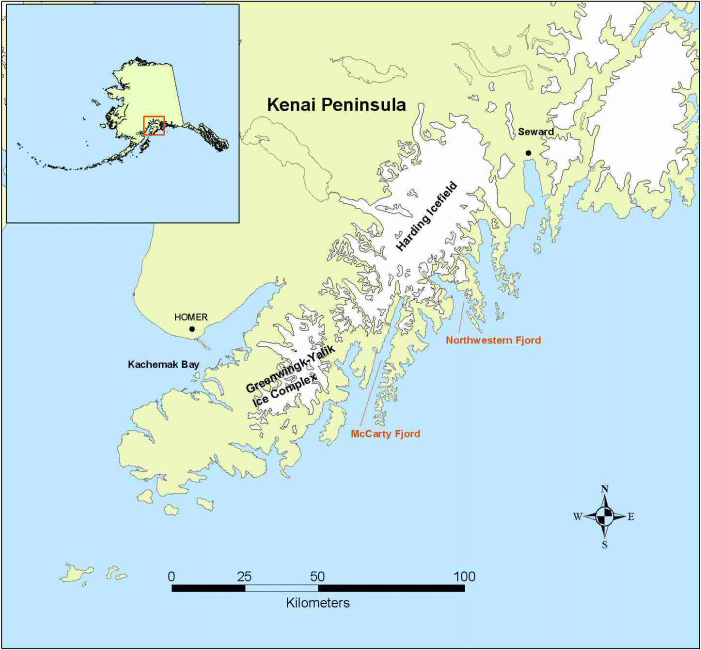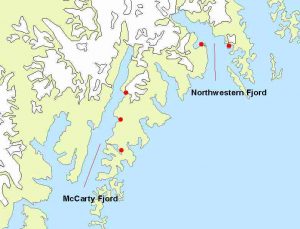Suzanne Lucas
Department of Geology
The College of Wooster
*This material is based upon work supported by the National Science Foundation under Grant No. 9910805. Any opinions, findings, and conclusions or recommendations expressed in this material are those of the author and do not necessarily reflect the views of the National Science Foundation.
Navigation
Introduction
Fjords, Glaciers, and Dendrocronology
There are two types of glaciers: tidewater glaciers and hanging glaciers. Those that terminate in the ocean are called tidewater glaciers, and those that descend only partway down the mountain slopes are called hanging glaciers. Many glaciers experience calving. Calving is when large pieces of ice break off at the terminus. A tidewater calving glacier is one whose terminus ends in a body of water. Calving is the most efficient way for tidewater glaciers to lose their ice mass (Van der Veen, 1997). A fjord is an area that has been carved out by an advancing glacier. Within the fjords lie subfossil (dead) trees, which are used to date glacial advances, and climate changes. The study of these trees, both living and subfossil, is called dendrocronology. Dendrocronology involves measuring and counting the rings within the cores and disks of selected trees found in the fjords and along moraines. Tree rings record environmental changes because unique rings are formed by extreme weather conditions. Each year a tree puts on another ring, and the width and density of these rings record the climate of the growing season. These unique rings may be identified in other trees, both living and dead. Through matching unique rings and ring sequences calendar dates can be assigned to these rings.
The Holocene
The term Holocene refers to approximately the last 10,000 years. Within the Holocene , two periods are particularly important regarding glacial activities; the Medieval Optimum, and the Little Ice Age. Most of the data found is from the Little Ice Age -occurring between A.D. 1200 and 1900- which is a time of varying and cooler climates (Grove, 1988). The Little Ice Age was preceded by the Medieval Optimum from about A.D.1000-1200 and, the early Medieval interval of glaciation from the late 6th through the middle 11th centuries (Calkin, et al., 2001).
Little Ice Age glaciation, starting approximately 750BP (1200AD), and continuing through the 19th century (Porter, 1986) was the same across Alaska. During this time, the majority of Alaskan glaciers reached their Holocene maximum extensions (Calkin, et al., 2001). Evidence that the Little Ice Age advances in the Kenai Mountains were the most expansive ones of the Holocene are reported in Glacial Fluctuations in the Kenai Fjords, Alaska, U.S.A.: an Evaluation of Controls on Iceberg-Calving Glaciers, (Wiles, et al., 1995).
The Medieval Warm Period (Medieval Optimum) has been described by Lamb (1965) as an epoch of anomalously warm conditions covering a period from A.D. 1000 to 1300 (Cook, et al., 2001). Advance dates during the Medieval Optimum in Alaska are within the 8th through the 12th centuries and occurred along a 500km transect along the southern coast (Wiles, et al., 2002).
Where are the Kenai Fjords located?
The Kenai Fjords are located on the southeastern Kenai Peninsula which is along the Gulf of Alaska, slightly southwest of Seward. Within the Kenai Mountains lies the Harding Icefield (300-square miles, 35 miles long and 20 miles wide) which overshadows both the McCarty and Northwestern Fjords. More than 40 glaciers decend from the Harding Icefield. (Figure 1).

McCarty Fjord
The McCarty glacier is a tidewater calving glacier. McCarty Fjord is a straight trough that extends 60km (Wiles, et al. 1995). Through dendrocronology and radio-carbon dating there is evidence of glacier advances as early as 3600 BP within the McCarty Fjord (Wiles, et al. 1995). An advance of about 350m has been recorded between 1978 and 1993 (Wiles, et al. 1995). A dramatic retreat over the past century has exposed many forest horizons which allow for more extensive studies of the area (Wiles, et al., 1995). Evidence of an Early Medieval advance down the McCarty Fjord currently comes from three dated samples (Wiles, et al., 1995).
The trunk glacier in McCarty Fjord was advancing to a mid-fjord area at about A.D. 1000 where the ice attained its terminal moraine position after A.D. 1790 (Wiles, et al., 1995). Delectable Bay, Desire Lake, and Delight Lake are areas in the McCarty Fjord which have supplied evidence of glacial advances and retreats. (Figure 2)
Northwestern Fjord

In addition to the McCarty glacier, Northwestern (located to the east of McCarty)is also a tidewater calving glacier. A 15km retreat of ice margins in the fjord over the last 90 years has revealed evidence that the trunk glacier underwent major advances during the past two millennia. The Northwestern trunk glacier advanced across the valley mouth an action that requires that the Northwestern Glacier margin to extend beyond mid-fjord by about A.D. 1110 (Wiles, et al., 1995).
The margin of the Northwestern trunk glacier began a rapid retreat from the terminal moraine about A.D. 1849 (Wiles, et al., 1995)
Sunlight Glacier, located in Northwestern’s Fjord supplies evidence, gathered from the broad outwash plain, of a subsequent readvance in the Northwestern Fjord (Wiles, et al., 1995). (Figure 2).
Conclusions
What is the significance of the Little Ice Age and the Medieval Optimum?
A possible advance of McCarty and Northwestern Glacier to a mid-fjord position at about A.D. 600 are reasonably compatible with Early Medieval advances of land-terminating glaciers (Wiles, et al., 1995). However, both glaciers extended well beyond this point 200 to 300 years prior to Little Ice Age advances, which means that they were extended during the Medieval Warm Period when land-terminating glaciers were in recession (Wiles, et al., 1995).
Why this happened is unclear . The movements may have been nonclimatically forced advances, or possibly pushed by increased precipitation (Wiles, et al., 1995).
Little Ice Age cooling appears to have let both systems reach their Neoglacial maximum between A.D. 1500 and 1800 (Wiles, et al., 1995). McCarty and Northwestern glaciers retreated from their Little Ice Age terminal moraines at about A.D. 1900, which coincides with other glaciers that are near sea level (Wiles, et al., 1995). This suggests that there are varying degrees of climate forcing in these calving glacier systems.
Web resources
- Kenai Fjords National Park The Kenai National Park web page provides background information about the specific area’s discussed above. From this site you can access many other sites of interest regarding the Kenai Fjords.
- Tree Rings This page is a complete description of all methods, and areas that involve tree ring dating and dendrochronology.
- Medieval Optimum A fellow undergrad student at The College of Wooster’s page that provides information regarding the Medieval Warm Period and its effects on Columbia Glacier.
- Calving Glaciers Megan’s page provides a detailed description of the characteristics of calving glaciers.
References cited
- Calkin, P.E., Gregory C. Wiles, David J. Barclay,. 2001. Holocene coastal glaciation of Alaska. Quaternary Science Reviews 20.449-461
- Cook, E.R., Jonathan G. Palmer, and Rosanne D. D` Arrigo, 2001. Evidence for a ‘Medieval Warm Period” in a 1100 year tree-ring reconstruction of past austral summer temperatures in new Zealand. submitted to GRLpp1-12.
- Grove, J.M., 1988. The Little Ice Age. Methuen, New York, 498.pp
- Porter, S.C., 1986. Late Holocene fluctuations of the fjord glacier variations during the last millennium. Quaternary Research 26, 27-48.
- Wiles, G.C., Parker Calkin, Austin Post, 1995. Glacier fluctuations in the Kenai Fjords, Alaska, U.S.A.: An evaluation of controls on iceberg-calving glaciers. Artic and Alpine research. 27.3.pp.234-245.
